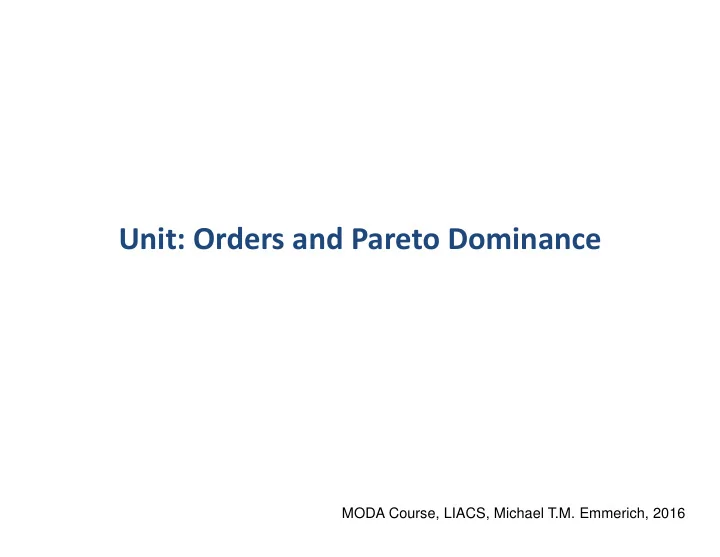

Unit: Orders and Pareto Dominance MODA Course, LIACS, Michael T.M. Emmerich, 2016
Learning Goals I. Recall: Definition of Pareto Dominance orders in Multiobjective Optimization, and relations that are based on it II. Learning about different types of ordered sets, in particular pre- orders and partial orders, and their fundamental properties. III. How to compare orders? How to represent them in a diagrams? IV. What is the geometrical interpretation of Pareto orders and the closely related cone orders?
Recall: Pareto dominance
Orders, why?
Binary relations
Preorders
Minimal elements of a pre-ordered set
The covers relation Aho, A. V.; Garey, M. R.; Ullman, J. D. (1972), "The transitive reduction of a directed graph", SIAM Journal on Computing 1 (2): 131-137, doi:10.1137/0201008,MR 0306032.
Topological sorting
Partial orders, posets
Pareto order, invariances
Examples: Preordered and partially ordered sets ≤
Total (linear) orders and anti-chains Poset that is neither a chain nor an antichain chain antichain (total order) What about Pareto fronts? Are they chains, anti-chains or none of these?
Comparing the structure of orders EXAMPLE c b a b a c
Maps on preorders
Drawing the Hasse* diagram
Example for a Hasse diagram Is covered by
The art of drawing ordered sets Three Hasse Diagrams of the same Order – Subsets of A={1,2,3,4}
(Linear) extension What about these orders on {a,b,c,d}? Identify (linear) extensions! The orders are d Represented by their Hasse diagrams.
Orders on the Euclidean space
Cones 0,0,1 (0,0,1) 0,1 (0,1,0) (1,0,0) 0,0 1,0 Examples for cones in 2-D (l) and 3-D (r)
Minkowski* sum and scalar multiplication *Jewish-German mathematician 1864-1909, Goettingen
Some properties of cones (2) 0,0,1 0,1 0,1,0 1,0,0 0,0 1,0
Polyhedral cones
Polyhedral cones: Example y = λ 1 d 1 + λ 2 d 2 y 2 λ 1 d 1 1 λ 2 d 2 λ 2 d 2 y 2 Basis: { d 1 , d 2 } d 2 d 1 y 1 0 λ 1 d 1 1 y 1 0
The negative orthant
Definition of Pareto optimality via cones or, equivalently:
Pareto Optimality and Cones f 2 ( � min) f 1 ( � min) Non-dominated solutions
Attainment curve
Definition of Pareto optimality via cones
Cone-orders and trade-off bounding What about cones with opening angle 180 ○ ? How can we çheck cone dominance?
Example of cone-order: Minkowski’s spacetime
Unit 2: Take home messages(1/2) 1. A formal definition of Pareto Orders on the criterion space and decision space was given 2. Orders can be introduced as binary relations on a set. The pair (set, order relation) is then called an ordered set. Axioms are used to characterize binary relations, and orders. 3. Preorders, partial orders and linear orders are three imporant classes of orders. Preorders are the most general type of orders.They are introduced (from the left to the right) by requiring additional axioms (antisymmetry, totatlity). 4. Incomparability, strict orders, and indifference are often relations that are defined in conjunction with an preorder.
Unit 2: Take home messages (2/2) 1. Orders can be compared in different ways: Order embedding, order isomorphisms, equality 2. Hasse diagrams are means to exploit the antisymmetry and transitivity of partial orders on finite sets in order to compactly represent them in a diagram 3. Topological sorting can be used to find a linear order that extends an partial order. It is an recursive algorithm. For a given partial order there can be different topological sortings. 4. The Pareto order is a special kind of cone order. Cone-orders are defined on vector spaces by means of a pointed and convex dominance cone. 5. Using the cone order interpretation we can easily check dominance and find Pareto fronts of 2-D finite sets, using a geometrical construction.
Recommend
More recommend